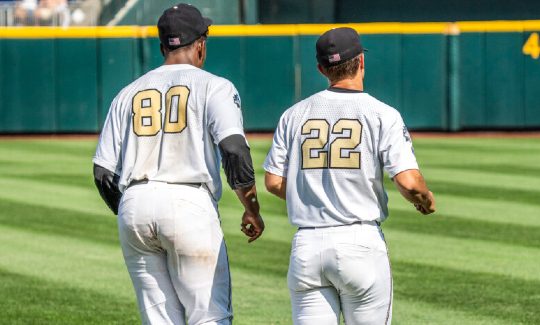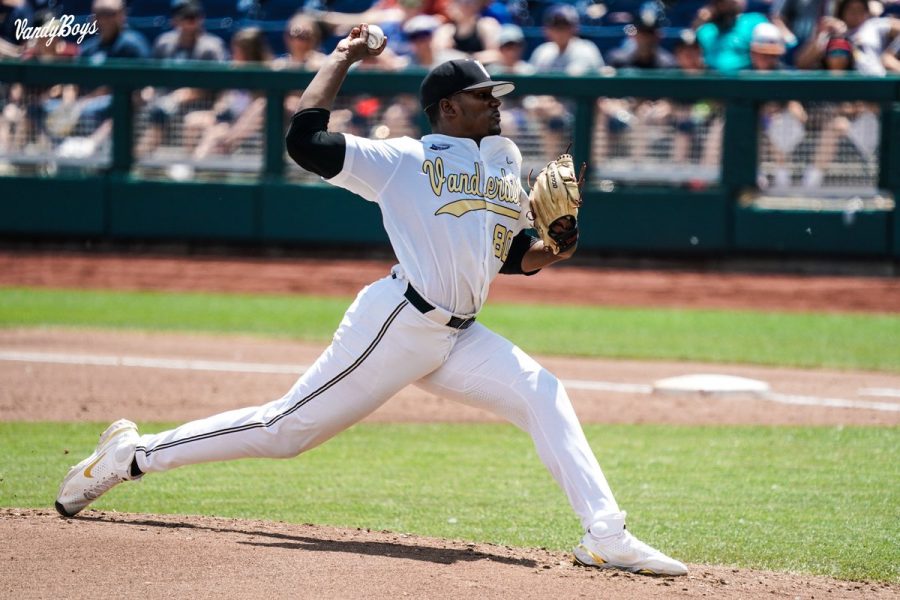Kumar Rocker’s journey to the major leagues has been anything but ordinary. During his three years at Vanderbilt, Rocker established himself as one of the best pitchers in both school history and collegiate baseball. The Georgia native burst onto the scene as a first-year, pitching to a 3.25 ERA at the front of the rotation en route to earning Freshman of the Year honors and helping Vanderbilt to its second National Title. Though Rocker missed most of his sophomore campaign due to the COVID-19 pandemic, he made up for lost time with an even more dominant junior season, allowing just 75 hits and 37 earned runs while striking out 179 batters in 122 innings.
After being selected in the MLB Draft not once, not twice but three separate times, the 6’5″ right-hander finally signed his first professional contract with the Texas Rangers in the summer of 2022. However, his first full season of minor league ball was cut short after just 28 innings when he was diagnosed with elbow soreness — an injury that ultimately required surgery. The rehabilitation process was long and grueling, but Rocker finally made his return to the mound this past July and quickly proved he hadn’t missed a step. In 29.2 innings between the Double and Triple-A levels, he pitched to a 0.91 ERA with a 0.57 WHIP, a stat line that ultimately led to the Rangers elevating him to their MLB roster on Sept. 12.
Rocker made three starts at the major league level after being promoted, tossing 11.2 innings while surrendering five earned runs and striking out 14. His electric pitch arsenal — which Vanderbilt fans became well-acquainted with during his time on West End — was on full display, making opposing hitters uneasy in the box. While he struggled to find the strike zone at times, Rocker’s elite potential was palpable each time he took the mound. Furthermore, the foundation he laid should serve as a solid launching pad for his rookie season in 2025. Let’s take a look at what worked and what didn’t for the 24-year-old in his introduction to The Show this fall.
The swing-and-miss pitch
Rocker’s breaking ball has long been his calling card on the mound. Whether it’s classified as a curveball, a slider or something in between, it has been virtually untouchable at every level. The same was true over his first three starts in the majors, where opponents struggled to make contact against the pitch, much less barrel it up. Of the 84 “sliders” Rocker threw this season, just three resulted in base hits. The pitch generated impressive statistics including an expected batting average of just .155, an average exit velocity of only 79.5 mph and a 50% whiff rate. That being said, the advanced metrics underlying it suggest it should be below average. Rocker’s breaking ball generates nearly five fewer inches of horizontal break than comparable major league pitches. It also spins at an average of just 2,231 rotations-per-minute (RPMs), a mark that comes in nearly 200 RPMs lower than the league-average breaking ball. So what makes Rocker’s breaking ball so effective?
The secret to the pitch is Rocker’s ability to locate it just outside the bottom right corner of the strike zone. Whether he’s working inside to left-handers or away to right-handers, the breaking ball is placed so that it begins in the strike zone but darts out of it before crossing the plate, making it nearly impossible to hit. Almost 49% of the time, the pitch landed below and to the first base side of the strike zone. Of those instances, 18 resulted in swings, 14 resulted in whiffs and just 2 resulted in base hits. Although the advanced metrics might not favor his breaking ball, Rocker’s command of the pitch completely transforms its effectiveness and places it not only at the top of his arsenal but also among the more dangerous breaking balls in the league.
The heaters
Though secondary to his breaking ball, Rocker’s pair of fastballs — a four-seam and a sinker — are no laughing matter. The more traditional of the two, Rocker’s four-seam averages 96 mph, though it likely plays up closer to 97 due to his 90th percentile extension. As is often the case with fastballs, it has been hit harder than his other pitches with opponents tallying 7 hits in 20 at bats against it, including a home run. That being said, when Rocker locates the four heater at the top of the strike zone, it’s highly effective, yielding three strikeouts and a slew of weakly-hit foul balls.
With 17.1 inches of arm-side horizontal break — 2.2 inches above league average — and more than 95 mph of velocity, Rocker’s sinker perfectly complements the four-seam. By locating it on the third-base side of the plate with nearly perfect precision (35 of 37 attempts), Rocker is able to run the pitch in on the hands of righties and away from lefties, creating plenty of soft contact. More importantly, however, the sinker has generated an average launch angle of -9 degrees off of it, inducing ground balls on nine of the 10 instances it has been put in play. Nothing warms a pitcher’s heart more than a ground ball double-play when they need it most and Rocker’s sinker should produce plenty over the course of his career.
Struggles with control
The one issue that plagued Rocker’s first few starts was an inability to consistently find the strike zone. Rocker never struggled with control in the past; he surrendered just 80 walks and 17 hit-by-pitches across 301.1 career innings between the collegiate and minor league levels, an average of just 0.3 free passes per inning. In his first 11.2 innings in the big leagues, however, Rocker walked six batters and issued an additional hit-by-pitch for an average of 0.6 per inning.
The underlying metrics behind Rocker’s ability to generate strikes are relatively encouraging as his zone rate (49.1%), chase rate (33.3%) and first-pitch strike rate (65.5%) were all above league average. That being said, he too often failed to locate his fastball in pivotal three-ball counts, resulting in less-than-desirable congestion on the basepaths. Rocker found himself in 13 three-ball counts between his three outings, escaping just seven without issuing a free pass and just five without allowing a base runner.
Finding ways to generate more deception and therefore higher chase rates on his fastball could help Rocker minimize free passes moving forward, as four of his six walks came on four seams up in the strike zone. Being more aggressive early in the count to shorten opposing plate appearances could also prove beneficial. Regardless, it should be noted that Rocker did not surrender a free pass in his most recent start against the Oakland Athletics — despite finding himself in three-ball counts on multiple occasions — displaying improvement from his first two outings. If he can continue that trend in the early stages of next season, he should have no trouble surpassing what appears to be the one clear barrier standing between him and dominance.
Given the hurdles Rocker has had to overcome over the past few years, it’s extremely encouraging to see him not only find his way to the major leagues but also find success once arriving. Much like his teammate Jack Leiter, Rocker still has plenty of work to do if he is going to establish himself as one of the better pitchers in the game. That being said, he possesses the velocity, movement and work ethic required to do so. It wouldn’t be surprising if Rocker finds himself among the contenders for American League Rookie of the Year next season.














